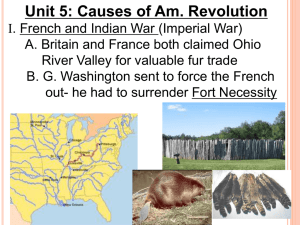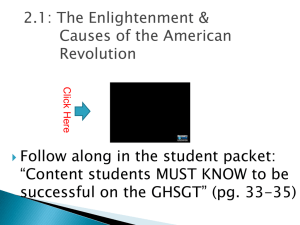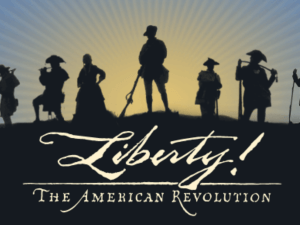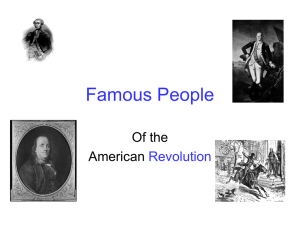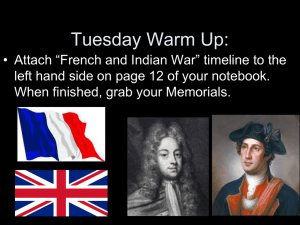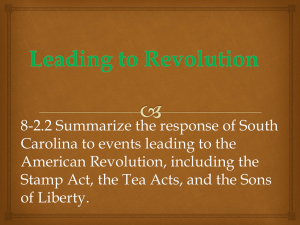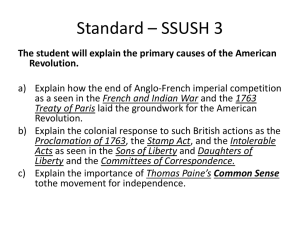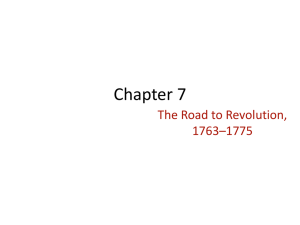American Rev. Review test
advertisement
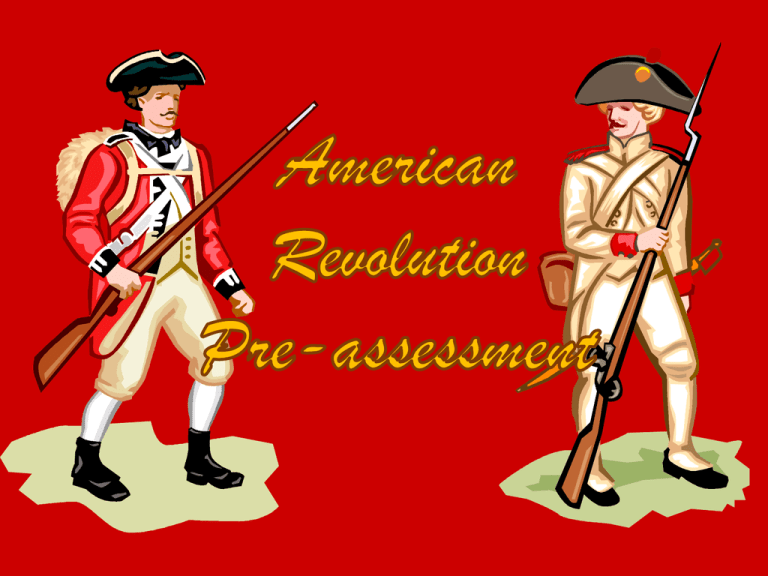
1. Who was the tyrant referenced in the Declaration of Independence? a. Queen Elizabeth b. King George c. Benjamin Franklin d. Thomas Paine 2. What is the best definition of tyranny? a. Not allowing citizens to have any say in the government b. Allowing a legislative body to determine tax policy c. Maintaining a standing army d. Passing laws that some people don’t like 3. The Declaration of Independence proclaimed that people were born with the following unalienable right(s). a. life b. liberty c. Pursuit of happiness d. A and B e. All of the above 4. Which conflict lead to the American Revolution? a. French and Indian War b. 100 Years War c. French Revolution d. World War I 5. Which document served as the framework for the U.S. government? a. Declaration of Independence b. Stamp Act c. Tea Act d. The Constitution 6. American colonists who were determined to fight the British until American independence was won were known as a(n) a. Loyalists (or Tories) b. traitors c. Patriots d. Native Americans 7. American colonists who supported and maintained ties to the Kingdom of Great Britain (and the British monarchy) during the American Revolutionary War were known as a(n) a. Rebels b. Revolutionaries c. Loyalists (or Tories) d. American Whigs 8. Judging from the French engraving by F. Godefroy, 1774, was John Malcolm a patriot or a loyalist? a. Patriot b. Loyalist 9. The order which stated that all lands west of the Appalachian Mountains were off-limits to the colonists for settlement. a. Proclamation of 1763 b. Stamp Act c. Intolerable Acts d. Tea Act e. Quartering Act 10. This act required that the soldiers from Great Britain be housed in American barracks and public houses. a. Proclamation of 1763 b. Stamp Act c. Intolerable Acts d. Tea Act e. Quartering Act 11. This act imposed a tax on all paper documents in the colonies. a. Proclamation of 1763 b. Stamp Act c. Intolerable Acts d. Tea Act e. Quartering Act 12. A law that gave one company, the East India Tea Company, the exclusive right to import tea to the colonies. a. Proclamation of 1763 b. Stamp Act c. Intolerable Acts d. Tea Act e. Quartering Act 13. Series of laws put in place as punishment to the colonists in response to the Boston Tea Party. a. Proclamation of 1763 b. Stamp Act c. Intolerable Acts d. Tea Act e. Quartering Act 14. What was the main issue that got colonists talking about revolution? a. b. c. d. Destroyed crops Taxes An unpopular British king A tea shortage 15. How did Thomas Paine inspire the American colonists? a. Through a series of public speeches b. Through a widely read pamphlet titled, “Common Sense” c. Through a series of newspaper articles d. By co-writing the Declaration of Independence 16. How did Ben Franklin help the American war effort? a. By writing the Declaration of Independence b. By serving as President of the Continental Congress c. By serving as a general in the Continental Army d. By convincing the French government to aid colonists 17. What role did Thomas Jefferson play during the Second Continental Congress a. He served as President of the Congress b. He was the first member to sign the Declaration of Independence c. He wrote the first draft of the Declaration of Independence d. He helped Ben Franklin edit the first draft of the Declaration of Independence 18. What role did Samuel Adams play in the American Revolution? a. He boycotted British goods in Boston. b. He promoted unity among all the 13 colonies in America. c. He formed the Minutemen, the first armed force to fight in the American Revolutionary War. d. b and c e. all of the above 19. How could the British government have prevented the American Revolution? a. By forcing King George III to give up the throne b. By allowing colonists to elect representatives to Parliament c. By overruling the decisions of the colonial legislatures d. By increasing taxes on the colonists 20. Which statement best describes a revolution? a. overthrowing one government and replacing it with another b. turning the soil in preparation for planting c. process in which a new leader is elected every four years d. process for determining the average income of people within a country
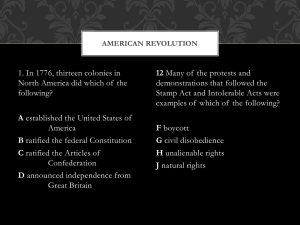

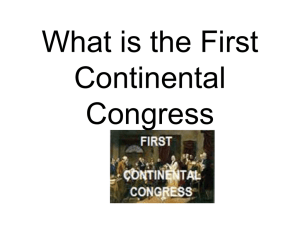
![Acts_of_Parliament[1]](http://s2.studylib.net/store/data/005574865_1-ce76322c4a4cd600a83e78bd35ae8f15-300x300.png)
